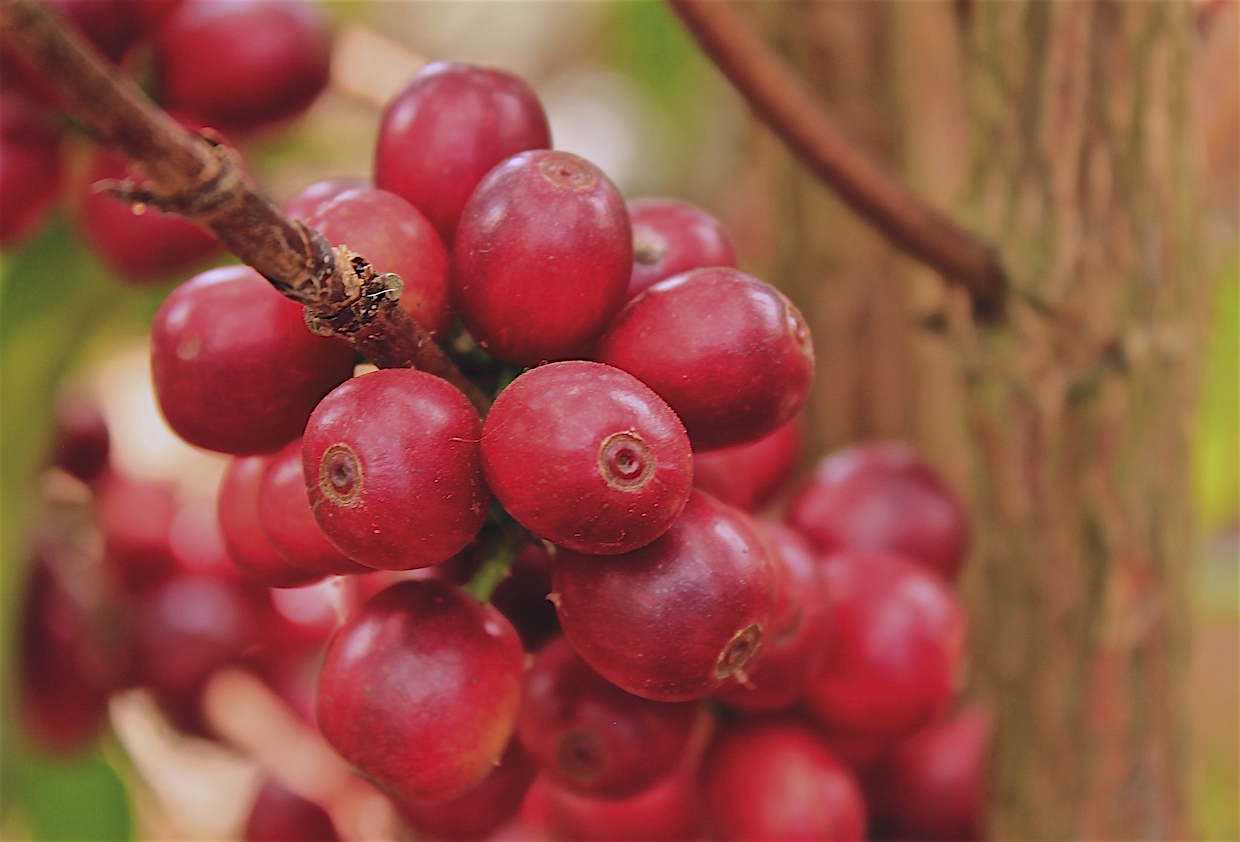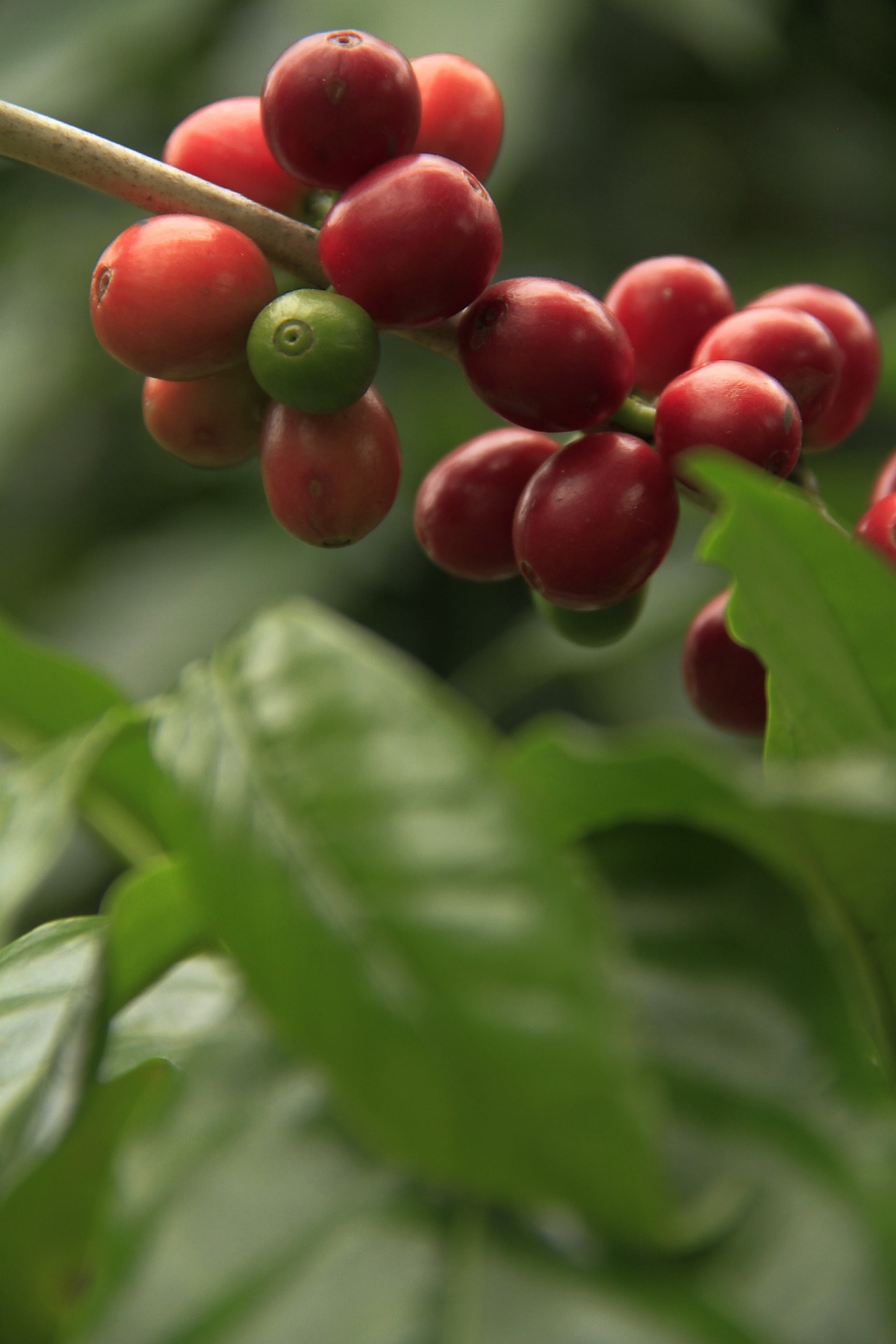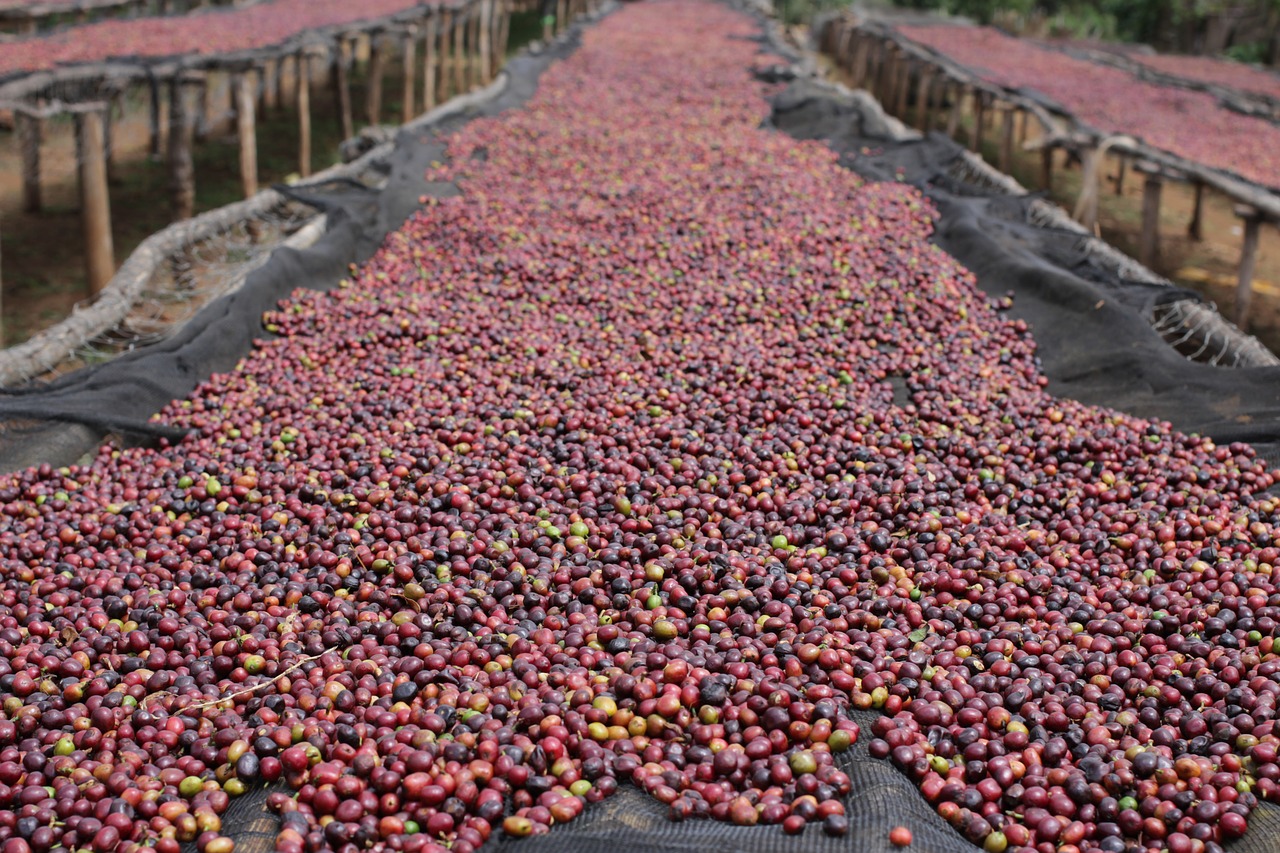
Ripe Geisha (or Gesha, depending on who you ask) cherries in Costa Rica. Photo courtesy of Cafe Imports.
Every professional community probably has its own take on “toe-MAY-toe, toe-MAH-toe,” but are any of them as knock-down, drag-out, and oddly fire-starting as the “Geisha” versus “Gesha” debate? (Let’s hope not.)
First, for the uninitiated, a little history: Geisha/Gesha is a variety — or is it a cultivar? — of coffee, thought to have originated among the many various native strains of Arabica found in Ethiopia, which is the birthplace of the species. The first real record of it was made in 1936, logged by a British consul who collected a sample of a variety located near what was dashed off as “Geisha Mountain.”
The samples bounced around a bit, with a selection ending up at CATIE in Costa Rica, from which various coffee farmers appear to have acquired their seeds to start planting the variety on their farms, the main interest being the coffee’s tolerance to several common diseases.
The History of ‘Geisha’
While the history of the variety itself is long and somewhat contested, Geisha’s big splash in the coffee world came relatively recently, in Panama, when a family farm called Hacienda La Esmeralda more or less blew away the competition at the 2004 Best of Panama competition with a variety called Geisha — a coffee so lusciously floral and sweet that it is unforgettable and unmistakable.
Since 2004, not only has the Esmeralda Geisha become internationally famous — selections of the green coffee have sold for hundreds of dollars per pound, green — but farmers around the world have had their interest piqued. Seeds and saplings of the Geisha/Gesha variety are finding their way into soils in Colombia, Honduras, Costa Rica, Brazil, all in an effort to, what else? Earn more money and capture some of the cachet.
The question here, however, is not whether or not the coffee is remarkable — because it certainly can be, and continues to win contests and turn heads — but rather what we should call it when we are making those worthy remarks: Is it Geisha, or Gesha?
When asked via e-mail, Rachel Peterson of Hacienda La Esmeralda said, “Regarding Geisha vs Gesha, it’s simple” — and simply a matter of history and record-keeping.
“We started the use of the word ‘Geisha’ because the person who brought the seed to Panama from CATIE in the early 60’s, Don Pachi Serracin, remembered it as Geisha 2722,” Peterson wrote. “This is because it was introduced to CATIE (Centro Agronómico Tropical de Investigación y Enseñanza) in Costa Rica in 1953 as Geisha, coming from Tanzania (where the accession number was Geisha VC-496), and previous to that from Kenya.”
Rachel also included documents showing that the coffee was indeed recorded as originating from the “Geisha” region of Ethiopia. Said Peterson, “We just used the historic spelling of the word.”

A letter from the British Consulate dated 1936 makes numerous references to Geisha Mountain and Geisha coffee. Letter shared courtesy of Rachel Peterson.
It’s absolutely true: Rachel shared with me a scan from the fascinating 1936 letter from the consulate to the Minister of Agriculture, which is the first known reference to Geisha’s coffee. In it, he wrote, “The wild coffee at Geisha to my inexperienced eye does not appear to be exactly the same type as that which grows wild in the forests at Lotti or Laboni in the Opari District of Mongalla Province Sudan. I have collected some coffee primaries from some of the Geisha trees and they are sent to you in the hopes that your experts may be able to classify the type.”
See? Even back then this coffee was mystifying. Earlier in the letter, he also wrote, “I had always understood in the past that the coffee at Geisha (considered by Abyssinians to be the best quality) was cultivated, but to my great surprise I found all the coffee growing wild in a huge area of rain forest, underneath the shade of huge trees of various African varieties…”
Additionally, right there in the supporting CATIE documents from the 50s — of which the Petersons also have copies — it says “2722 – Arabica – Geisha,” as plain as the day is long. That historic spelling might, however, actually be just slightly mistaken, probably simply due to pronunciation and written-language barrier: While there is no Geisha Mountain in Ethiopia, there is a place called Gesha, typically pronounced more like GEH-shah than GAY-shah.
Origination and Geography
Maybe you’re thinking this seems cut-and-dry enough, based simply on origination and geography. “What originated from Don Pachi in Central America should be ‘Geisha,’ because it’s maybe from the Gesha Mountain region, but maybe not,” said Sara Gibson from Greater Goods Roasting Company. “Coffee that is grown in Ethiopia near Gesha Mountain — which is often a mix of heirloom varieties — should be ‘Gesha.’ Consumers may not want or need the distinction, but I would like it!”
Roaster and Q-grader instructor Candice Madison agreed, saying concisely, “‘Gesha’ for Africa, ‘Geisha’ for Centrals.”
Yet, here’s where the rub begins. “The coffee roaster I currently work for sources their ‘Gesha’ from Colombia, but the plant itself traces back to Africa: It’s still considered ‘Gesha’ because of where the plant originated from,” said Alexandria Dancy, who works with Devoción. “Any other Geisha I have come across has had Central American origins (e.g: Panamanian Geisha) because the variety is believed to have just start growing without being imported from elsewhere.” (We can have a year-long debate about whether any variety “just starts growing,” but maybe another time.)
For Tim Hill, head of sourcing and roasting for Counter Culture Coffee, this is a particularly interesting subject—not only because of his extensive research into variety-specific Arabica from Ethiopia, but also his deep and abiding love for the place, its language and its culture.
“As there is no defined translation from Oromo or Amharic to English, there is no true defined spelling. Ideally, it is the most phonetic spelling to have English speakers say the word correctly,” Hill said. “This said, as far as I have heard native speakers say it, it is actually somewhere in the middle of the two. Most researchers in the 1930s through 2000s outside Ethiopia spelled it ‘Geisha,’ and hence this is why we know it as such. Most researchers and documents from Ethiopia I have seen spell it ‘Gesha.’ However, a lot of English translated words I have seen in terms of regions, places, proper names, etc, are pretty far off from a ‘best’ phonetic spelling.”
The Geisha Subtext
Added to this mess, the word “Geisha,” as it originated in a non-coffee context, carries a very specific set of often misunderstood, misinterpreted, and certainly misappropriated connotations that make the coincidental similarity of the words unfortunate at best and deeply disturbing at worst.
“On the one hand, the fact that we inherited the name just is what it is, but do I think that the initial group [of roasters involved in popularizing Geisha in the early 2000s] really did position Geisha as this like sexy, sexualized, exotic thing,” said writer Hanna Neuschwander. (Neuschwander is the communications manager for World Coffee Research, but spoke on the condition that her opinions be presented as her own and not necessarily endorsed by WCR.) “It’s impossible that it wasn’t ringing those bells, and that they weren’t intentionally exploiting that potential that it had to connote the things that the word ‘Geisha’ connotes, which is refined, expensive prostitutes — that’s what white people think ‘Geisha’ means. It’s not accidental. I don’t think there was necessarily any ill intent behind any of it, but I do think there is more appreciation now than there was 10 or 15 years ago that that stuff does matter, and it does resonate through culture and have consequences.”
Lest we think it doesn’t resonate, take a quick glance at some of the high-profile descriptors used for Geisha (or Gesha) coffees lately: Just recently, for instance, a post on this very website reported on the record-breaking sale of Ninety Plus’s José Alfredo Gesha Series — which, confusingly, is spelled as “Gesha” but described as “[evoking] feelings of ‘multifaceted inspiration, erotic innervation, epiphany, possibility,’ and ‘femininity,’” as well as simply, and rather coarsely, “the color pink.”
Said Neuschwander about the tendency for many of us in the industry to describe Geisha/Gesha this way: “I don’t want to read more into it than it is, but it’s relatively straightforward and clear that you’re capitalizing on this connotation of sex to sell your fancy coffee. Fine, everybody capitalizes on sex to sell things, but I think we’re at a cultural moment to say, ‘Eh, maybe sometimes I’m not OK with that.’”
“I have a friend who is of Japanese descent, who doesn’t work in coffee, who came across a coffee labeled ‘Geisha’ in a shop and was very upset about the apparent commodification of Japanese culture for seemingly no reason,” said Bailey Arnold of Gregorys Coffee. “If the history I‘ve been taught is correct, we spell it ‘Geisha’ simply because of sonic similarity to the name of the place it came from (Gesha), with an added bonus of exoticism as a selling point. For these reasons, I lean toward ‘Gesha’ both in spelling and a slight (probably) mispronunciation.”
Dr. Merry White, professor of food anthropology and author of Coffee Life in Japan, said, “As a specialist and writer on Japanese coffee culture, I too think ‘Geisha’ is confusing and leads to orientalist packaging (I saw one bag with a ‘Geisha’ on it dressed in deshabille, not actually what a true geiko (Kyoto geisha) would wear, so my vote is ‘Gesha.’”
(By the way, when you look up Gesha on Wikipedia, there is a note under the headline that says, “Not to be confused with ‘Geisha.’” Are you confused? I’m confused.)
Marketing vs. Good-Faith Etymology
Furthermore — as though that weren’t enough to wring one’s linguistic hands over — there’s the fact that no matter which word gets used, regardless of intention, someone is going to get cute about it and offer a correction, and if you don’t think that’s true, quickly scroll through the comments of any blog post or Instagram caption that mentions the variety, even in passing. That have-to-be-right attitude makes the whole mess even more confusing and elitist to consumers, who honestly just wanted a cup of really good coffee. Is that too much to ask?
There’s one last issue at play here, too — well, the are actually about a hundred more issues, but space is limited — which is, whose right is it to name or rename a product for marketing purposes, even if what it came with is offensive or troubling?
In this traceability-obsessed age of specialty coffee, what if an import or roaster were to discover a farm-specific microlot from a place called something like, say, Finca Motherf$&@er? If your standard is to identify a farm by name, do you also have the right to make the identifying quality more G-rated? When a farmer grows and sells what he or she in good faith believes is a variety called Geisha — regardless of where it comes from, short of DNA testing — is it appropriate for an importer or roaster to sell it as Gesha, whatever the reason?
David Perreira of Yellow Brick Coffee offers this last thought: “There is clearly a bit of philosophy and linguistics intertwined. If we know that the variety has followed the journey that Gesha indeed has, and we attempt to give it one identifying name, are we negating its etymology?,” he said. “Are we trying to prevent it from evolving? Then again, if we know that the variety is the same no matter where it is grown and regardless of how it is written or pronounced, the same product can be called multiple things and we don’t necessarily have to choose just one.”
So… what do you choose? Does a coffee by any other name taste so floral, so enchanting, and, yes, so sweet?
Ever Meister
Ever Meister is a journalist and coffee professional who has written about and worked in the specialty coffee industry for more than 20 years. In addition to writing about coffee for both mainstream and trade publications, Meister is the author of "New York City Coffee: A Caffeinated History" (The History Press 2017).
Comment
5 Comments
Comments are closed.








Yirgacheffe, Yirgacheff, Irgachefe
You forgot Yirga Cheffe. 😉
As an Ethiopian born journalist and fanatic coffee goer I often wonder how the word “Gesha” or “Giesha” evolved. In my view and and also pointed out by one of the voices presented in the story. There is no place called Gesha in Ethiopia. I guess the word Gesha came out of Ethiopian Amharic language “Kesha” that stands for a wrapping bag made of hard-dried palm leaves. It’s commonly used by those coffee farmers to keep the coffee beans tasty, uncontaminated and wild.
oh really
No place in Ethiopia called Gesha. No Gesha Mountain ?
but why many coffee guru still talk to geisha come from gesha mountain.
There is a principal coffee town called Gesha in southwest Ethiopia. It’s located at approximately 35°30E and 6°34N. But according to the Coffee Atlas of Ethiopia, it’s a decent growing region but not an especially great growing region.